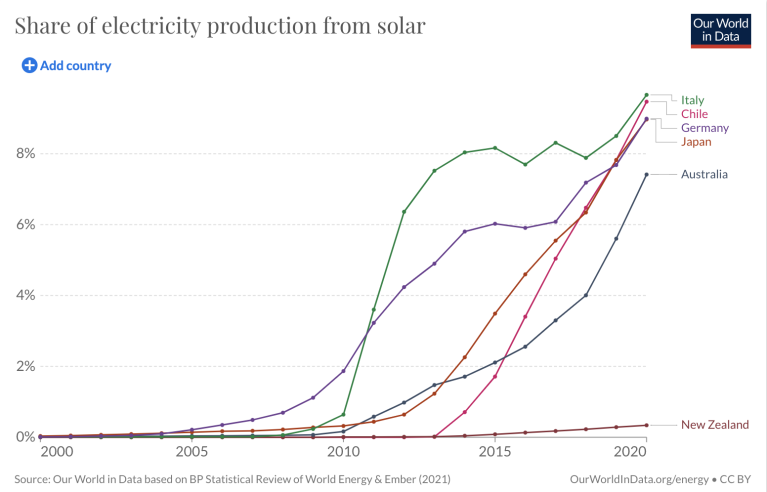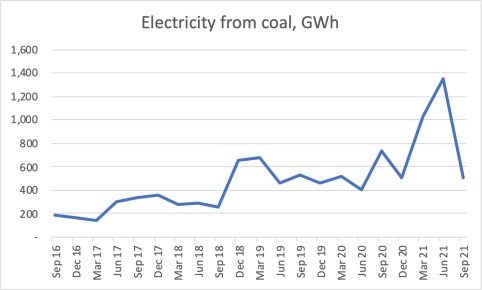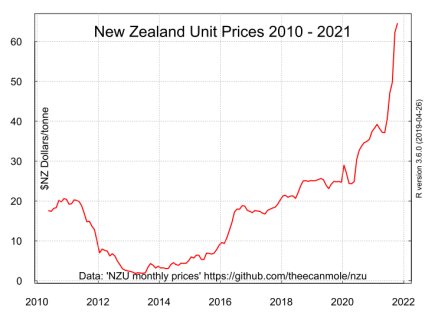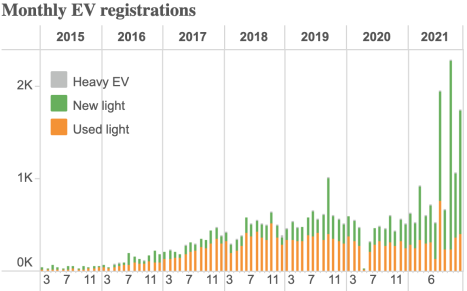
By Robert McLachlan*
2021: the fourth year of the Labour-led government; the first in which it governs alone; the second year of the Covid pandemic; the last year before the Zero Carbon Act kicks in for real. What was achieved for the climate?
In terms of actually cutting emissions, – like removing petrol cars and coal boilers – not a lot. Apart from the Covid-induced slowdown, it’s unlikely that emissions have started falling. But changing the entire energy system takes time and preparation. 2021 was a year in which more ducks got in a row than ever before, some of them ducks never before seen in these parts.
Let’s check out those ducks and hear them squeak.

Duck 1: Renewable energy, especially solar.
If 2019 was the end of a long wind drought, 2021 was the year in which solar power finally appeared.
Before this year, New Zealand’s largest solar farm was Watercare’s 1 MW array, opened in October 2020.
Then in March, Kea Energy’s 2 MW solar farm in Marlborough (with 2-sided, sun-tracking panels!) was mostly completed.
In May, Lodestone Energy announced plans for 160 MW of solar across five locations in the upper North Island, to be built over 2021–2023.
In June, Kapuni Energy’s 2 MW solar farm in south Taranaki was completed.
In July, Far North Solar Farms kicked off their first 10 MW solar farm, Pukenui, in Northland, and announced plans to build 1000 MW by 2025.
In August, Genesis Energy announced a 60% stake in a joint venture for 500 MW of solar farms, to be built over the next five years.
In December, Christchurch Airport announced a 150 MW solar farm, 30 MW of which will be built initially.
These farms are small compared to what is being built overseas, where 500 MW solar farms are now common, and small compared to what we’ll need in the future – perhaps 20,000 MW by 2050, which sounds like a lot, but it’s how much Australia has built in the past five years – but they are much larger than anything seen here before now.
The combination of falling solar costs and increasing certainty that the government is determined to cut emissions seems to have finally done the trick. Solar now costs about 7c/kWh to build, about the same as new wind or geothermal power.
Australians have been installing staggering amounts of home rooftop solar. We’re not seeing that here yet, although the combination of falling costs and rising electricity prices are bound to have an impact soon. A home solar array now costs $8000, and earns about $800 a year for the owners.

Some world leaders in rapid solar roll-out. It’s possible to scale up the solar industry rapidly and cheaply to add 2% of electricity per year. For New Zealand, that would mean building about 300 MW each year.
Less was happening in other areas, although stage 1 of the Turitea wind farm was progressively switched on, and in February, Meridian approved construction of the 176 MW wind farm at Harapaki near Napier.
Also in February, Contact Energy decided to build the 152 MW Tauhara II geothermal plant. This had been suspended last year because of uncertainty over Tiwai Point closure, which in January was delayed to 2024. Although better than coal or gas, the plant will emit 170,000 tonnes of CO2 a year, a point that was scarcely considered ten years ago when consent was granted.
In November, the second offshore wind energy conference was held in Taranaki, home of plentiful wind and shallow seas. (See the slides of the talks.)
So far, none of this has led to any coal or gas plants being decommissioned. That should happen soon.
Duck 2: Coal angst.
Mainstream and social media were fired up during the year by the massive increase in coal burning for electricity. Many pointed at the immediate cause, namely low lake levels, rather than the longer-term problem of a failure to build renewable supply and to phase out fossil fuels entirely. To the public it seemed to indicate a flaw in the whole idea of electric vehicles (Indonesian coal!!!), but at least the basic idea that coal is bad seems to have been understood.
As the lakes filled and the new wind farms switched on, the problem receded, hopefully never to return.

Not what you should be seeing in a climate crisis. (Source: MBIE).
Duck 3: Transition plans appearing.
In February, the Climate Change Commission released their draft advice, containing the carbon budgets out to 2035 and suggested pathways for achieving them. In November, the government responded, not with a plan as they had been required to do, but with an “Emissions Reduction Plan Discussion Document“. The plan itself has been delayed until May 2022. The document was criticised as half-baked. Only the transport section was fully detailed, probably because the Ministry of Transport had been hard at work for a while, releasing “Hīkina te Kohupara – Kia mauri ora ai te iwi: Transport Emissions: Pathways to Net Zero by 2050” in May. We’re starting to hear the creaking of some very large and interlocked wheels as our entire society prepares to change direction.
Each time a report like this appears, or indeed, any climate action at all is proposed, Matt Burgess from the New Zealand Initiative (formerly the Business Roundtable) comments that the suggested actions will not cut emissions by even a single tonne of CO2, because emissions are capped in the Emissions Trading Scheme. The argument is that any emissions cut in one place will be permitted to be emitted somewhere else. I wonder just what actions he thinks would in fact cut emissions, if the argument applies so universally. David Hall and I took apart his argument in a study of the international experience of emissions trading, which finds that it’s just one part of the whole system and cannot work just by itself. (David also wrote this week that Matt Burgess formerly worked for Charles River Associates, an economics consultancy that played a pivotal role in weakening, defeating, and delaying US climate policy since the late 1980s.)
Just to remind you of the scale of the problem, in April the figures for New Zealand’s 2019 emissions were released, and they were not good. They had shot up again, with CO2 emissions up 10%, or 3.8 million tonnes, in the three years 2016–2019.
Duck 4: Carbon price.
After years in the doldrums, the carbon price in the New Zealand Emissions Trading Scheme finally took off, reaching $65 by the end of the year. (In Europe, prices reached 91 euros, $156.)

Source: Wikipedia.
The whole market is rather complicated and mysterious. Some of these units have been purchased for future use, hedging against the expectation of higher prices. However, the government can choose to release fewer units in the future depending on the size of the stockpile, which would then send prices higher again.
In August, the government agreed to progressively raise the price ceiling each year, to reach $110/tonne in 2026. If the ceiling is reached, the government can choose to release extra units. This happened for the first time on 1 September, when 7 million units (permission to emit 1 tonne of CO2) were released, all of which were sold. The government may have to “pay back” these emissions in the future, although the cap on emissions doesn’t start until 2022.
In July, there was a consultation on reforming the free allocations given to certain export industries, such as tomato growers heating their greenhouses with coal.
But at a certain point, the Emissions Trading Scheme starts to make my brain hurt, so I’ll stop here.
Short version: higher carbon price = good; full picture not clear.
Duck 5: Legal action.
In July, Lawyers for Climate Action New Zealand filed for a judicial review of the Climate Change Commission’s advice, stating that the proposed emissions budgets are “irrational, unreasonable, and inconsistent with the purpose of the [Zero Carbon] Act”. The claim will be heard in the new year.
In August, All Aboard Aotearoa sued Auckland Transport and Auckland Council over a transport plan that fails to reduce emissions.
In December, the sustainable transport group Movement filed for a judicial review of the New Zealand Transport Agency’s $24 billion spending plan, on the grounds that it does not take into account their requirement to reduce transport emissions.
Duck 6: Action on car emissions, finally.
The Clean Car Plan, the brainchild of Green MP Julie Anne Genter, which was to have brought in fuel efficiency standards and a system of CO2-based fees and rebates on new cars, was famously scuppered in 2020 by coalition partner New Zealand First. Freed of that shackle by the election, it resurfaced in June 2021 with a surprise twist: the rebates were front loaded and would come into effect immediately, in July. Market share for EVs jumped from 2% to 7%.

Source: Ministry of Transport.
When we got to see the whole package, there was a further surprise: new emissions targets had be added for 2026 and 2027, and they are sharply lower. They will put us on track to end the import of petrol and diesel cars by 2030. The fossil parts of the car industry complained vociferously. The bill is now in parliament’s select committee, who will report back in February 2022.
Duck 7: Money for climate… next year.
Between the motorway-heavy “NZ Upgrade” programme, announced in February 2020 just before Covid, emissions-heavy Covid stimulus spending (criticised by the Climate Change Commission), and one disappointing budget after another, government spending has not reflected the government’s supposed climate focus. One big win this year was the announcement in May that revenues from future auctions under the Emission Trading Scheme will be dedicated to climate change. Further details emerged this week: revenue of $4.5 billion over four years, and will go towards international climate aid, adaptation, and mitigation. Definitely a good start; in a year or two it should become clear whether emissions are tracking down fast enough.
Duck 8: Glasgow and the NDC.
Despite heaps of (sometimes confusing) media attention on COP26 in Glasgow – if you missed it, you could do worse than watch Jonathan Pie’s very funny and on-point short film The World’s End – there was finally an agreement on the rules for international carbon trading. New Zealand has been relying on this, as just before COP26 our updated UN pledge was announced. Climate Minister James Shaw got the headline he wanted (“emissions to halve by 2030”) but the reality is somewhat different. Even Climate Change Commission head Rod Carr declined to say that the pledge met their advice.
There are so many potential problems with this, it’s hard to know where to start. For one thing, it is hard to imagine New Zealand spending billions of dollars to reduce emissions elsewhere while we continue to pollute at home. If I had to look for a silver lining, it would be that the target is a big step up on what we had before, and it will serve as an additional source of pressure to cut our own emissions.
So those are my eight ducks in a row, eight mostly hopeful signs of climate action in 2021. If it was all too cheerful and positive for you, don’t worry, the next post will look at some of the things we’re still overlooking and which I hope will receive more attention in 2022.
*Robert McLachlan is a professor in the School of Mathematical and Computational Sciences, Massey University, and writes on climate and environmental issues at planetaryecology.org and in other media.
43 Comments
Great summary.
Australia's domestic solar installers have had the benefit of generous government subsidies, for 15-20 years now. they had a scale to build on that NZ lacked. Around 2000,a major manufacterer looking to open a NZ branch,told me the market for all of NZ was less than one major Australian city. they did not proceed.
10% return per annum for home solar sounds attractive. Why wouldn’t the government want to encourage domestic generation? It is being blocked by the power companies? Surely adding solar to every new build and social housing development would be a start. The area of roofs in Auckland is huge and would save farmland being turned into solar farms.
No. Why should it? I can't think of any serious activist who wants to "remove NZ farming as a legitimate activity". Not only do we need to eat, but in order to afford the measures we need to take, we need to earn money and much of our overseas income comes from agriculture.
However, it is also true that any serious activist wants changes to some farming practices such as the overuse of artificial fertilisers, on both climate and environmental grounds.
China can't feed its current population.
Here's something that certain industries, governments and media don't really want you to know...
Matt Burgess was right on one thing though - it is true that NZ's agricultural production is efficient. We nerf that, NZ's production is replaced by less efficient (i.e. more carbon intensive) production elsewhere. We can't have money from agriculture and no carbon from agriculture in the near future.
Ironically though, the new carbon tax proposals reward the least efficient producers. They aim to reduce our carbon footprint by reducing production, this will increase the CO2E per unit of production, making us less competitive.
In the proposal the price is set by CO2E per unit of land, while for our exports the criteria is CO2E per unit of produce. If everyone farmed like me our overall emissions would go up, but our emissions per unit of production would go down. It's sad they have tried to create a less productive economy, may as well quit the farce and disband the productivity commission.
Well, maybe net zero needed to consider what was going to happen in the real world? In the stroke of a pen much of Europe and the UK is now beholden to Russia for energy. I suspect the rise of China and Russia are going to be a much bigger threat than climate change.
But there is hope in the fact that many of the old/original IPCC scenarios are not how we are tracking (i.e., the 4+degC warming scenarios). IPCC AR6 (the latest report) has found the high end RCP8.5 scenario to be now implausible. Tracking still suggests we're heading toward above a 2degC change - but doomsday or 'hot house earth' is looking less, and less likely;
Solar having an impact in Australia buts its a lot more than just throwing up a lot of panels - distribution, managing power surges etc etc
Still it can be done
https://www.abc.net.au/news/2022-02-03/renewables-make-power-prices-amo…
Unfortunately most grid connect systems been installed are not been used to their full potential . Many just put panels on , with no power management or even advice for the customer. So alot of power is exported back to the grid , getting 7 cents kw/h , rather than been used and saving 25 cents a kw/h. simple things like telling the homeowner it is best to use power when the sun is shining , to timers on hot water cylinders , to the more elaborate systems that measure loads and power produced , and match them accordingly.
so many are not getting that 10 % return they were expecting.
Agee
Im building a new house (well trying to!!) and luckily my son is an engineer who analyses these things to death - we will need to change when we use the power to get best benefit - batteries don't stack up financially.
Washing, dishwasher, hot water recharge, charge car etc during the day instead of after 9pm.
He estimates around 7% return
Im not sure the return is actually that high - Im expecting 2 to 3% as Im going with higher end, higher cost panels( Ive invested in lots of stuff over my life and its never as good as expected) but Im not worried about making money on the panels - as long as Im no worse off Im happy to do my little bit. Im lucky though and can afford to put in the upfront cost.
Build your house to be more efficient from the get go. My panels have been returning about 30% but we have no heating load and low total load.
Passive House should be mandated for new builds. Otherwise houses being built now are locking in extra emissions for decades and retrofitting is much more expensive than doing it right the first time.
FYI, I get 12c/kWh for my export.
Agree
Im putting on a warm roof, thermally broken walls - simple concept around dwangs which is not that expensive, Thermal broken windows, Well insulated slab - not a passive house but miles above the normal build code. Im sure there are lots of things we could incorporate into building codes that would greatly improve efficiency and therefore reduce the power demand,/ongoing cost while delivering better health outcomes which wouldn't be that much more up front but save a heap on downstream problems and costs.
Solar panels seldom fail , I think I've seen maybe 1 a year fail on average over my 20 or so years in the game. Thats why they give 25 year warranties Between the reputable brands , any performances / life expectancy differences are mainly sales talk . Its the inverter / control gear side where you want to make sure you are getting good quality equipment.
Most Chinese panel with a brand name are good quality. E.g are Trina , Jinko etc . go on actual rated output . Avoid no name or unknown name ones.
The % efficiency only really matters if you have limited roof space , you generally pay more for more efficient panels.
I'm an electronics engineer and solar still doesn't stack up. It may be better for a family of 4 or more but for 1 person in the house its a no go. Quite liked living in a place that had an evacuated glass tube setup on the roof however, basically in the summer your hot water is free and its a very reliable system with just a small water pump and digital controller so no power electronics or batteries. The batteries are the killer but if you had say 2 electric cars that you alternated and was able to charge but also take power from it would work better, but again the up front cost is huge unless one day we are all driving electric cars and 2 of these is standard in the garage anyway. The cost of a solar system that you can simply forget your on solar and use it like a grid supply is cost prohibitive still.
A totally off grid system (with batteries) does not make economic sense (payback ) at the moment. The cost and replacement of the batteries kills it . Its a lifestyle choice.
Grid connect solar does payback, somewhere between 5% to 20 % , depending on cost of system , and how much is used vs exported to the grid, and at what price.
The best payback is for commercial systems , who are generally using all the power produced during the day .
Let's hope our politicians can get their act together on intensification and public transport instead of "MOAR ROADS!!1!" to the middle of nowhere. They say "more roads" in the same breath as "give people options" while completely failing to give most of them any other option than personal car travel.
NZ is uniquely placed to maximise the utility of solar and wind. We already have the storage in the great southern lakes, when solar and wind production is high, we can take less from hydro and keep that available for when we need it. I'm generally sceptical about the claims made about solar, but in NZ I think we can do it better than most, although even at 400 GWH of coal power we are going to need at least 4,000 100MWH solar plants just to cover it on very sunny days. Still a very long way to go.
Seven out of eight ducks seem to more talk than action, but time will tell I suppose.
I'm afraid Duck #5 is going to have to do the heavy lifting. Thank goodness for an active civil society!
And on Duck #6. As the Aussie kid says in the Mitre10 commercial, "you're dreamin' mate" (i.e., the end of fossil imports by 2030). Unless of course, the government intends we mimic the Cubans and keep the existing fossil fleet going for 50+ years. Problem with that is (to my limited understanding) you can't repair 'modern' vehicles to the same degree you could the old classics.
The feebate scheme can only be accessed (to my mind) by wealthy people who buy cars in cash and/or those upgrading fleet/company vehicles with the generous depreciation advantages afforded to business owners.
We have this big bulk of the population (baby boomers) retiring in the next 0-10 years. Quite a quantity being cash poor, asset rich types. They're not likely going to take out a commercial car loan or a commercial second/reverse mortgage in order to upgrade to EV (are they?). But we really need a quick uptake to meet that 2030 intention (don't we?)
Hence, how do we use the pent-up (asset) capital of retiree homeowners for the betterment of society going forward in terms of the big/massive energy transitions needed? And if EVs are ever going to be in the reach of our general population (old and young/rich and poor alike)- then we need used EVs coming on the market in plenty as well.
Any thoughts from readers on a government scheme whereby a cash poor/asset rich retiree can put the car on the house via an interest-free lien on the asset. When the title holder of the vehicle dies - the government gets paid via the lien on the asset - and the car gets sold on the secondary market?
I'm sure there is a fish hook..
Most of us don't need to tote a ton of metal with us to do our short hops. Safety-in-weight is just a commons thing; if we all drove pedal cars the impact thing would be equal, but impact-ratings would cost zilch. So bikes, e-bikes, e-scooters, mobility scooters, public transport, e-light-rail (not to airports, they're headed where Concorde and the Challenger have already gone).
I hear you there. As a means to overcome the commons issue though, these alternatives need a safe/dedicated path before you'll get serious uptake. I've thought one of perhaps the best things we could do is remove all public carparking on residential roadsides in order to provide that safe/dedicated path for those short hops. Public parking being a part of the historical use of the commons which exacerbated the mess we're currently in with those 1-ton metal shopping baskets and single-family school buses. :-).
.
Well if we don't need bigger heavier cars so why have we all gone mad on SUV's and even bigger cars that can weigh nearly 2 tones ? I suspect its the perception of safety ? mines bigger than yours if you crash into me ? Something about the human psychology thats inhibiting the move to much smaller cars, I mean much smaller and much lower cars with smaller engines and much better aerodynamics. You could also fit more on the road and increase the number of lanes on the existing roads. I suspect its coming one day when petrol hits $10 a liter.

We welcome your comments below. If you are not already registered, please register to comment.
Remember we welcome robust, respectful and insightful debate. We don't welcome abusive or defamatory comments and will de-register those repeatedly making such comments. Our current comment policy is here.